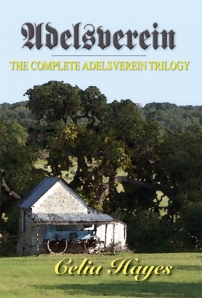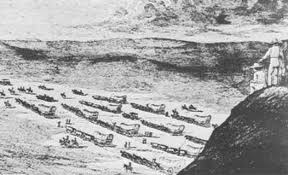Fifteen miles a day, more or less; the inexorable calculus of the overland trails. The wagon trains can only move out in late May, when the prairie grass is grown tall enough to feed the draft animals. And they must be over the last palisade of the high Sierra Nevada before the way is blocked by the winter snow. And they must do so before their food supplies run out. Any one of a hundred miscalculations, missteps or misfortunes can upset that careful arithmetic and bring disaster upon all. Is the water in that creek running fast and high? Can it be forded, or should the wagons carefully and laboriously be ferried over. An accident to a wagon, the loss of any of the supplies, an ox-team felled by disease or accident may be compounded later on. Balance taking a day to cross a high-water creek, against a day six months in the future and an early snow fall in the Sierras. Balance sparing a day camping by a pleasant spring of clear water, and the men going to hunt for meat – which when dried over the fire and stored away, may mean the difference between a nourishing meal by an ice-water lake half a continent away, and starvation in that place instead.
All accounts of the emigrant trail agree, some of them very lyrically, that the first weeks out on the trail are the most pleasant. Dr. Townsend’s journal, as he was nominated the secretary from the Stephens Party, is long gone, but many other emigrant accounts from various other parties remain. The prairie grass is lush and green, the land gently rolling. The oxen are healthy and rested, the burden of travel not onerous. Elderly men and women in San Jose, or Portland, penning their memoirs early in the 20th century will look back on it as the most marvelous adventure of their childhood; running barefoot in the green grass, the white canvas wagon-top silhouetted at the top of a gentle rise against a blue, blue sky, meals around a campfire, and sleeping under the stars. They will remember seeing herds of buffalo, a sea of brown woolly backs as far as the horizon goes, the trick of scrambling up from the ground over a slow-moving wagon-wheel, and how the wagon jolted over every little rock and rut. They will remember the look of the Platte River, wide and shallow— and inch thick and a mile wide, so it was said, and how they also said it was too thick to drink and too thin to plough. For small children, alive in the immediate day to day present, and innocently trusting their parents as all-wise, all-capable beings, those first weeks on the trail could only be a grand adventure, an endless picnic excursion, with something new and wonderful always around the next bend.
For their mothers, it was a picnic well stocked with ants and dust and the endless chore of cooking over an open fire, of setting up camp every night, and unrolling the bedding, or carrying buckets of fresh water – all that after an exhausting day of either walking alongside the wagon or riding in it. Women’ work on a farm in those days was grueling enough by our standards, but in the settled lands they had left there was a community, family, friends, an orderly routine. These eight women and the older girls in the Stephens-Townsend Party would have formed their own little community; discovering again that a bucket of milk hung from the wagon-box in the morning would have churned itself into a small lump of butter at the end of the days journey, and dried beans left to soak overnight in the dying heat of the evening campfire would be ready to cook the next morning. How to contrive meals out of cornmeal and flour, dried beans, dried fruit, salt-pork, how to do at least a minimal laundry along the trail, how to glean edible greens and wild plums from the thickets in the creek bottoms. The presence of Dr. Townsend, with his medical expertise, and small range of surgical kit must have also been very reassuring, most especially as the party reached the landmark of Independence Rock, shortly before July 4th. There Mrs. James Miller gave birth to a baby daughter, named Ellen Independence Miller. When the party moved on towards the distant Rocky Mountains and Fort Hall (in what is now Idaho), it was on a shortcut of Isaac Greenwood’s suggesting. It would later be called Sublette’s Cutoff, and it saved them five days of travel.
The westbound trail split at Fort Hall. From then on, the Murphys, the Townsends, the Millers and their infant daughter, Old Hitchcock and his daughter, and all the others would be on their own, and finding their own trail in the faintest of traces left from wagons who attempted the California route the year before.
The eleven wagons led by Elisha Stephens and guided by Greenwood, the old trapper and mountain-man, struck off the main trail in the middle of August, following the wheel tracks of a group led the previous year by another mountain man and explorer, the legendary Joseph Walker. Walker’s party had followed the Humboldt River, a sluggish trickle of a river which eventually petered out in a sandy desert basin well short of the mountains. Walker’s party had been unable to find a pass leading up into theSierra Nevada, had gone south and eventually abandoned their wagons near Owens Lake, reaching California by going around the mountains entirely. This was a desperate and impractical solution for the Stephens Party.
They camped by the desert marsh; experienced frontier hands Greenwood and Hitchcock were convinced there had to be a way up into the Sierra, more or less directly west of where they were camped, and they consulted, mountain-man fashion with a curious, but seemingly friendly old Indian man who wandered into camp. They may not have known it at the time, but the old Indian was the chief of the Piute tribe, and had made the acquaintance of the explorer John C. Fremont— traveling into California with Fremont, even— and made it tribal policy to be courteous and friendly to those settlers and explorers passing through Piute lands. Communication seems to have been through sign language, and pantomime. Was there a pass into the mountain-range? Greenwood or Hitchcock modeled a range of mountains in the sand at their feet and pointed at the real mountains. The old Indian looked at it thoughtfully, and carefully remodeled the sand range to show a small river running down between two. Could there be a gateway through the mountains?
He seemed quite positive there was, and the next day he rode ahead towards the distant mountains with Greenwood and Stephens, while the rest of the party rested and waited for the scouting party to return. When they did, they brought the good news; there was a river, coming down into the desert, cutting a passable gateway — and the bad news; it was a hard journey across barren desert, and no water at all save for a small, bad-tasting hot-spring halfway there. Careful preparations were made; everything that could be made water-tight was filled to the brim. They cut armfuls of green rushes and brush as fodder for the cattle and their few horses. Some accounts have them deciding to start across the desert at sundown, and just to keep going, all night, the next day, and into the next night. Take advantage of the night’s cool temperatures, minimize the need for water and get out of the desert as soon as possible. As much water as possible would be reserved for the oxen, on whose strength and pulling power survival depended. Perhaps the smallest children would be tucked up in the wagons for the grueling trek; everyone else would walk, stumbling half-asleep under a desert moon.
(To be continued)






Recent Comments